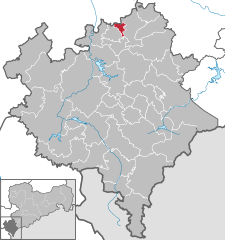Mylau
| Mylau | ||
|---|---|---|
| ||
 Mylau | ||
Location of Mylau within Vogtlandkreis district 
 | ||
| Coordinates: 50°37′N 12°16′E / 50.617°N 12.267°ECoordinates: 50°37′N 12°16′E / 50.617°N 12.267°E | ||
| Country | Germany | |
| State | Saxony | |
| District | Vogtlandkreis | |
| Government | ||
| • Mayor | Christoph Schneider (CDU) | |
| Area | ||
| • Total | 4.73 km2 (1.83 sq mi) | |
| Elevation | 305 m (1,001 ft) | |
| Population (2012-12-31)[1] | ||
| • Total | 2,699 | |
| • Density | 570/km2 (1,500/sq mi) | |
| Time zone | CET/CEST (UTC+1/+2) | |
| Postal codes | 08499 | |
| Dialling codes | 03765 | |
| Vehicle registration | V | |
| Website | www.mylau.de | |
Mylau is a town in the Vogtlandkreis district, in the Free State of Saxony, Germany with 2912 citizens. It is situated in the valleys of the Göltzsch river and the Raumbach, a stream flowing from Reichenbach im Vogtland that is locally known as the Soap Stream (German: Seifenbach) because of the textile painting factories that had been built by its banks. The town lies 6 km southeast of Greiz, and 20 km southwest of Zwickau.
.jpg)
History
In the 14th century, a settlement was built at the foot of Mylau Castle (1180). Emperor Charles IV granted town privileges in 1376. Until late in the 17th century, the town was reasonably insignificant; in 1650 it was composed of only 24 houses. It then grew rapidly because of a rise of manual weaving craftsmanship in the area, which facilitated the rapid development of the textile industry in the 19th century.
Population growth (as of 1960, the poll date is December 31):
|
|
|
|
- Data before 1998: Digitales Historisches Ortsverzeichnis von Sachsen
Data since 1998: Statistisches Landesamt Sachsen
Sites of interest
Mylau Castle was built in 1180 at the place where the Raumbach flows into the Göltzsch river, and is still intact. One kilometer to the northwest of the town the world-famous Göltzsch Viaduct crosses the Göltzsch valley. Also worth visiting is the city church St. Wenzel established in 1890, which includes a Gottfried Silbermann organ built in 1730/1731).
-
.jpg)
Mylau Castle
-
.jpg)
Mylau Castle inner courtyard
-
.jpg)
City church (rear view)
See also
 Media related to Mylau at Wikimedia Commons
Media related to Mylau at Wikimedia Commons- Municipal Web site (German)
- City information (German)
- Digitales Historisches Ortsverzeichnis von Sachsen (Digital Historic City Directory of Saxony) (German)
References
- ↑ "Statistisches Landesamt des Freistaates Sachsen – Bevölkerung des Freistaates Sachsen jeweils am Monatsende ausgewählter Berichtsmonate nach Gemeinden". Statistisches Landesamt des Freistaates Sachsen (in German). 17 June 2013.
